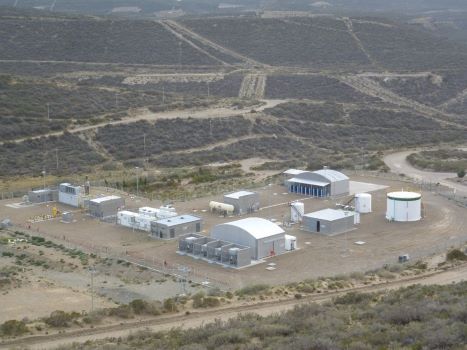Green hydrogen
Hychico - Argentina
|
Basic description Argentina’s local oil company CAPEX has founded Hychico in 2006 in diversifying its activities towards electricity generation and now it controls the company that is based in Buenos Aires. Hychico’s operations in renewable energy started in December 2008 with the Diadema demonstration project. The green hydrogen project benefits from experience of a decade of operations. The project located in Rivadavia City, Patagonia, includes 6.3-megawatt (MW) wind power capacity comprising seven 0.9-MW turbines and a 1.4 MW electrolysis capacity of two alkaline electrolysers. The project’s production capacity is 120 normal cubic meters (Nm3) of hydrogen per hour (h) (equivalent 10 kilograms per hour) and 60 Nm3/h of oxygen. The high purity hydrogen (99.998%) is mixed with natural gas to feed a 1.4 MW gas turbine producing electricity. Hychico tested up to 42% concentration of hydrogen in the mix, showing good performance and efficiency in reducing emissions of carbon dioxide and air pollutants, namely carbon monoxide and nitrogen oxide. Hychico aims to develop activities in the green hydrogen value chain including the production of renewable power. The company has been working on an underground hydrogen storage pilot project since 2010, including a 2.3-kilometre (km) hydrogen pipeline. The company is now investigating options to develop large-scale projects in South America. Project rationale Diadema is a small-scale demonstration project with the objective to acquire operational capacity well ahead of market development. Hychico’s many years of operational experiences from electrolysis, storage, transport and distribution of hydrogen will be a key success factor to overcome the challenges to develop GW-scale projects. |
 |
|
|
Governance all along the value chain Diadema project is fully owned and developed by Hychico. In the future, a different ownership model can be put in place for large-scale projects that can help to bring in new sources of finance and experiences of other companies. While a holistic approach to oversee the entire project development and operation across its value chain has been beneficial for Diadema project, Hychico’s takes a different approach for the commercial phase, aiming to create individual special purpose vehicles (SPVs) for each phase of the value chain to mitigate risks. In this case, while Hychico plans to remain majority shareholder for the renewable electricity production SPV, its shareholding participation could be more limited in the activities covering hydrogen production, storage, transport and export terminals. Business Model The large-scale projects in Latin America will benefit from high wind and solar availability. Hychico has reached annual capacity factor of 50% in its demonstration project in Patagonia. Then, green hydrogen could be used for applications with the most advanced commercial maturity, such as ammonia, whose production process already uses (fossil fuels based) hydrogen today, and for which production and transport infrastructures already exist. As the economic viability of projects in the short term remain challenging, Hychico explores the options to valorise the surplus wind electricity generated in the power market. Additionally, by-products from the electrolysis process can be used in an industrial area to bring down the cost of hydrogen production. Thus, the presence of industry to consume heat and oxygen and the access to electricity transport infrastructures to offtake the surplus will be important factors in the location selection. |
Enabling market conditions and investment de-risking
A new National Hydrogen Law and a regulatory framework could help to update and expand the 2006 published first National Hydrogen Law of Argentina. This renewed regulatory frame should allow the development of a National Hydrogen Strategy and increase the exposure of Argentina as a potential supplier of green hydrogen for international markets. The government can also help mainstreaming the permitting and licensing process, which can take 3 to 5 years for large-scale projects.
On the project development side, three main elements are major enablers to reach the final investment decision. First, securing a sustainable supply of low-cost renewable power – ideally for a long term - through power purchase agreements (PPAs) and the sales of hydrogen with agreements. As opposed to long-term PPAs, sales agreements could be shorter duration since the market is nascent, provided that they offer a reasonable price that ensure cost recovery. Second, the availability of common infrastructure shared with other users (e.g. desalination plant, hydrogen storage, pipelines, dock and jetty) helps accelerate project development and minimises the investment costs for the project developers. Finally, a pull mechanism to create local demand can be fostered by political measures such as green hydrogen mandates for fertiliser producers, or the development of new standards to boost green fuels use in the shipping or mining industries.
Financing
Hychico focusses on project finance solutions through the development of individual SPVs for each phase of the value chain. For the more mature phases such as the wind power plant, no significant financing barriers are expected. The whole value chain for green hydrogen production is capital intensive, thus improving the cost of finance will play a prominent role to achieve green hydrogen production costs at a competitive price.
Industrial consortiums and a pool of finance institutions will be required to share risks and ensure the viability of the first-of-a-kind large-scale projects. Hychico already has experience in working with industrial consortiums, multilateral and commercial banks.
Related Documents
